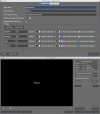Development and Usability Evaluation of a Desktop Software Application for Pain Assessment in Infants
- PMID: 35005387
- PMCID: PMC8730649
- DOI: 10.1080/24740527.2018.1540261
Development and Usability Evaluation of a Desktop Software Application for Pain Assessment in Infants
Abstract
Background: Pain assessment is a key component of pain management and research in infants. We developed software to assist in coding of pain in infants called PAiN (Pain Assessment in Neonates).
Aims: The aims of this study were to evaluate the usability of PAiN in terms of effectiveness, efficiency, and satisfaction among novice and expert users and to compare the efficiency and satisfaction of PAiN to existing software for coding of infant pain among expert users.
Methods: A quantitative usability testing approach was conducted with two participant groups, representing novice and expert end-users. Testing included an observed session with each participant completing a pain assessment coding task, followed by administration of the Post Study System Usability Questionnaire and Desirability Toolkit. For comparison, the usability of existing coding software was also evaluated by the expert group.
Results: Twelve novice and six expert users participated. Novice users committed 14 noncritical navigational errors, and experts committed six. For experts, the median time for completing the coding task was 28.6 min in PAiN, compared to 46.5 min using the existing software. The mean Post Study System Usability Questionnaire score among novice (1.89) and expert users (1.40) was not significantly different (P = 0.0917). Among experts, the score for the existing software (4.83) was significantly (P = 0.0277) higher compared to PAiN (1.40). Lower scores indicate more positive responses.
Conclusions: Users were highly satisfied with PAiN. Experts were more efficient with PAiN compared to the existing software. The study was critical to ensuring that PAiN is error free and easy to use prior to implementation.
Contexte: L’évaluation de la douleur est une composante clé de la prise en charge et de la recherche sur la douleur chez les nourrissons. Nous avons développé un logiciel pour aider à codifier la douleur chez les nourrissons appelé PaiN (Pain Assessment in Neonates).But: Évaluer l’utilisabilité de PaiN en termes d’efficacité, d’efficience et de satisfaction auprès d’utilisateurs novices et experts, et comparer l’efficacité de PaiN et la satisfaction d’utilisateurs experts au logiciel existant pour la codification de la douleur chez les nourrissons.Méthodes: Une étude quantitative pour tester l’utilisabilité a été menée auprès de deux groupes de participants, représentant des utilisateurs finaux novices et experts. Le test comprenait l’observation d’une session où chaque participant devait effectuer une tâche de codification de l’évaluation de la douleur, suivie de l’administration du Post Study System Usability Questionnaire et du Desirability Toolkit. À des fins de comparaison, l’utilisabilité d’un logiciel de codification existant a aussi été évaluée par le groupe expert.Résultats: Douze utilisateurs novices et six utilisateurs experts ont participé à l’étude. Les utilisateurs novices ont commis 14 erreurs de navigation non critiques, tandis que les experts en ont commis six. Pour les experts, le temps médian pour effectuer la tâche de codification a été de 28,6 minutes pour PaiN, comparativement à 46,5 minutes lorsque le logiciel existant était utilisé. Le score moyen obtenu pour le Post Study System Usability Questionnaire chez les utilisateurs novices (1,89) et les utilisateurs experts (1,40) n’était pas significativement différent (p=0,0917). Parmi les experts, le score pour le logiciel existant (4,83) était significativement (p=0,0277) plus élevé comparativement à PaiN (1,40). Les scores plus faibles indiquent davantage de réponses positives.Conclusions: Les utilisateurs étaient très satisfaits de PaiN. Les experts ont été plus efficaces avec PaiN qu’avec le logiciel existant. L’étude était d’importance priomordiale pour s’assurer que PaiN ne contienne aucune erreur et soit facile d’utilisation avant sa mise en oeuvre.
Keywords: Premature Infant Pain Profile; infant; pain; pain measurement; software; usability.
Published with license by Taylor & Francis Group, LLC.
Figures
Similar articles
-
A usability design checklist for Mobile electronic data capturing forms: the validation process.BMC Med Inform Decis Mak. 2019 Jan 9;19(1):4. doi: 10.1186/s12911-018-0718-3. BMC Med Inform Decis Mak. 2019. PMID: 30626390 Free PMC article.
-
Importance of testing for usability when selecting and implementing an electronic health or medical record system.J Oncol Pract. 2010 May;6(3):120-4. doi: 10.1200/JOP.200017. J Oncol Pract. 2010. PMID: 20808553 Free PMC article.
-
A usability evaluation of medical software at an expert conference setting.Comput Methods Programs Biomed. 2014;113(1):383-95. doi: 10.1016/j.cmpb.2013.10.006. Epub 2013 Oct 21. Comput Methods Programs Biomed. 2014. PMID: 24210868
-
Striking a balance between usability and quality control in electronic health records.S Afr J Surg. 2022 Sep;60(3):171-175. doi: 10.17159/2078-5151/SAJS3767. S Afr J Surg. 2022. PMID: 36155371
-
Methodological Quality of Manuscripts Reporting on the Usability of Mobile Applications for Pain Assessment and Management: A Systematic Review.Int J Environ Res Public Health. 2020 Jan 27;17(3):785. doi: 10.3390/ijerph17030785. Int J Environ Res Public Health. 2020. PMID: 32012674 Free PMC article.
Cited by
-
Designing eHealth Interventions for Pediatric Emergency Departments: Protocol for a Usability Testing Study With Youth, Parent, and Clinician Participants.JMIR Res Protoc. 2025 Apr 14;14:e64350. doi: 10.2196/64350. JMIR Res Protoc. 2025. PMID: 40228237 Free PMC article.
References
-
- Stevens BJ, Johnston CC.. Physiological responses of premature infants to a painful stimulus. Nurs Res. 1994;43:226–31. - PubMed
LinkOut - more resources
Full Text Sources
Other Literature Sources



